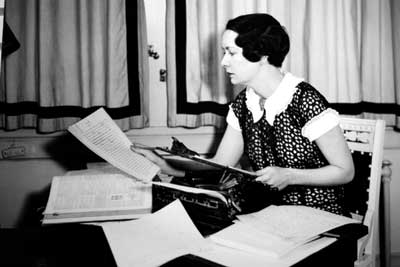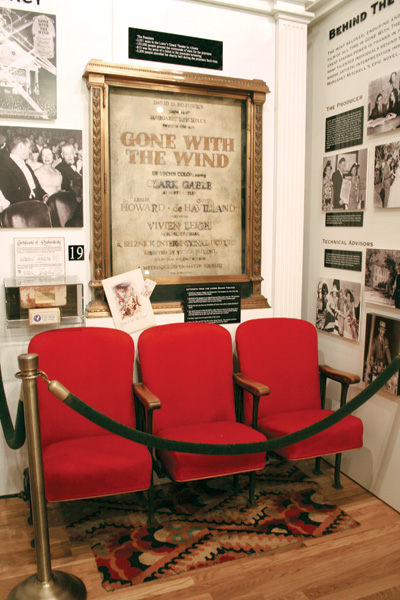Even the most fiercely self-disciplined Southern belle is bound to have some creases and creaks as she hits 70. Yet here is a Dixie septuagenarian still smooth of cheek, bright of eye, and lithe of figure.
Of course, she’s had work done—expert work. Because no one would trust Gone with the Wind to anyone but the best cinematic plastic surgeons.
The film, which catapulted Britain’s Vivien Leigh to icon status as Scarlett O’Hara and immortalized Clark Gable as the only possible Rhett Butler, will celebrate its 70th birthday this December. Thousands are planning pilgrimages to Georgia, the setting for the book and scene of the premiere. Marietta, Georgia, is even restaging the three-day GWTW gala of 1939, with spotlights criss-crossing the night sky and the remaining cast members walking the red carpet.
But what, really, is left after all this time—73 years after Margaret Mitchell unleashed the world’s best-selling novel?
Never underestimate the South’s love of tradition and, especially, its tenacious stewardship of all things GWTW.
From an original Scarlett gown to Mitchell’s Remington typewriter, there’s plenty to experience. Here are some of the milestones to help you map your own epic adventure.
Questing for Tara

GWTW fans—called “Windies”—long for the towering white pillars of Tara, but the mansion we love was basically a confection whipped up by producer David O. Selznick.
The native Pittsburgher, who called GWTW “the American bible,” envisioned a plantation house like the antebellum mansions lining the Mississippi. Mitchell’s Tara, however, was modeled after her great-grandparents’ farmstead in Clayton County, a two-story frame house with a comfy porch. The family called it “Rural Home.”
In a tribute to her Irish ancestry, Mitchell named her fictional estate Tara for the hill of Tara, 30 miles outside Dublin, where Ireland’s first High King was declared.
“When Margaret Mitchell saw the film, she said, ‘That’s not the house I wrote about,’ ” said Ted Key, a costumed docent at Stately Oaks in Jonesboro, Clayton County.
Built in about 1831 by Mitchell’s Irish ancestor Philip Fitzgerald, Rural Home is now in ruins. Instead, head down Carriage Lane to Stately Oaks, an 1839 home in the Plantation Plain style of Rural Home.
“Windies always ask, ‘Is this Tara?’ ” Key said. “It’s as close to Tara as you’re going to get.”
During the Civil War, the Robert McCord family lived in the house, which was moved four miles in 1972. Mrs. McCord, her six children, and the cook were hiding alone
in the home when Union soldiers broke into the basement and found them.
An officer stationed a guard at the front and back doors to protect them, then asked a favor of the lady of the house. Would her cook make his officers home-cooked meals?
“That’s the way the house was saved,” Key said.
It was on the porch of her family farmhouse, similar to Stately Oaks, that young Mitchell heard tales of the war.
“I heard about fighting and wounds… how ladies nursed in the hospitals…the way gangrene smelled. …I heard about the burning and looting of Atlanta. I heard everything in the world except that the Confederates lost the war. When I was 10 years old,” Mitchell recalled, “it was a violent shock to learn that General Lee had been licked.”
Hollywood may not have gotten Rural Home right, but it did create an indelible illusion beloved around the world.
In 1979 Georgia’s First Lady, Betty Talmadge, bought the studio façade of Tara’s doorway, now located at Atlanta’s Margaret Mitchell House and Gone with the Wind Museum.

Tracking the GWTW Manuscript
Travelers would love to see the original pages of the world’s best-selling novel, but Margaret Mitchell wouldn’t have it.
Her second husband, John Marsh, who encouraged Mitchell to write, said her will placed upon him “the duty of destroying her papers. … She believed that an author should stand or fall before the public on the basis of the author’s published work.”
Only 20 or so pages survive, and if you really want to see them, there’s only one thing to do.
Sue.
“There are a few pages in the SunTrust Bank, where they will remain unless someone challenges her authorship,” said Richard Cruce, the librarian who handles the Mitchell collection at the Atlanta-Fulton Public Library System.
But you won’t leave the library disappointed. Fans from 38 states and 13 countries came last year to see the Remington typewriter that Mitchell wrote GWTW on—last chapter first. She wrote out of chronology from 1926 on, eventually weaving the chapters together about 1935.
The manuscript may be out of reach, but the Margaret Mitchell House has the clipboard she corrected it on. And the suitcase that Harold Latham of Macmillan Publishing bought to carry away the manuscript.
He’d come from New York to scout for new writers. When he met Mitchell at a writers’ conference and asked if she had work to show, Mitchell said, “No, I have nothing.”
A friend urged her on, and Mitchell finally went to the Georgia Terrace Hotel just as Latham was leaving. She handed over 70 bulging envelopes and said, “Take the damn thing before I change my mind.”
Searching for the Loew’s Grand

Gone with the Wind was a publishing sensation, even at an astronomical $3 each. It sold more than 28 million copies worldwide.
Barely was the ink dry before movie buzz started. Clark Gable, “King of Hollywood,” would play Rhett, everyone decided. The actor, however, resisted all the way. Finally, his studio, MGM, loaned him out for the role, and Selznick added $50,000 to the deal, enough for Gable to divorce Ria Langham and marry Carole Lombard. Lombard urged him to take the part, and now no one can imagine anyone else as Rhett Butler.
Scarlett was trickier. The search would take two years, cost more than $92,000, and involve 1,400 actresses, from Lana Turner to Lucille Ball.
Ninety candidates took screen tests, with four in full color: front-runner Joan Bennett, Jean Arthur, Paulette Goddard, and Vivien Leigh.
Selznick, of course, swooned for 25-year-old Leigh, who traveled from London to land the role.
“Better an English girl,” sniffed a Daughter of the Confederacy, “than a Yankee.”
Atlanta, of course, was determined to host the world premiere, and the lavish Loew’s Grand was the place.
“The premiere was like a snowflake in Atlanta,” said Beth Bailey of the Clayton County Convention and Visitors Bureau. “We shut down everything for one snowflake. People didn’t go to work, didn’t do anything but try to see actors from Gone with the Wind.”
The city dolled up the Grand, built in 1893, with faux Tara pillars and raked the night sky with searchlights on December 15, 1939. All the stars arrived, somehow dwarfed by the 4-foot-11-inch figure of Margaret Mitchell.
Sadly, the Grand burned in 1978, and only fragments remain. The Road to Tara Museum has three of its red plush seats, a playbill, a railing, and a scrap of art deco carpet.
Atlanta’s Fox Theatre, built in 1929 as a Masonic temple, has taken over the heritage role with classic movies, including GWTW. It even has a few of the Grand’s seats. Ironically, they’re up in the standing room only area of the top balcony, a section reserved for blacks during segregation.
Staying at the Stars’ Hotel
You can still book the Clark Gable suite at the Georgian Terrace Hotel. The ballroom, a white vision of Corinthian columns and chandeliers, was the setting for the film’s post-premiere party.
“Every day,” said Carl Dees, general manager of the hotel, “someone comes into this ballroom to take pictures.”
Unveiling the Costumes
Walter Plunkett created some of film’s most iconic costumes. Who can forget Scarlett’s green velvet drapery gown?
He took the costumes after filming and willed most of them to the University of Texas, where they remain in storage.
Only one of Scarlett’s original gowns is on display, and it draws Windies from around the world to Marietta’s Scarlett on the Square. It’s her ivory bengaline silk gown that Rhett bought her on their honeymoon in New Orleans.
At the Road to Tara Museum in Jonesboro, seamstresses have devoted thousands of hours replicating GWTW gowns. They had the green-sprig fabric for Scarlett’s barbecue dress specially milled and sent plumes to Las Vegas to be dyed just the right burgundy for the gown Scarlett wore to Ashley Wilkes’ birthday party.
And when they replicated the green drapery gown and hat, they added a real chicken’s foot to the cording on the hat, just as Scarlett wore it. For true Windies, no detail is too small.
Become a Saturday Evening Post member and enjoy unlimited access. Subscribe now




Comments
Thank You for writing this article in a national magazine. I have been a “Windie” since 1989, but viewed the movie for the first time in 1969 on an U.S. Army post.
Scarlett on the Square GWTW Museum, in Marietta GA, hosted by Chris Sullivan and Connie Sutherland, have done great justice to GWTW, by keeping the novel and the movie memories flowing in the hearts of the many fans and readers who respect the body of work Margaret Mitchell, has written. A close-knit, “Family of Windies” from across the U.S. are looking forward to The 70th Anniversary Celebration of GWTW in November. Forget Atlanta, this is going to be” the place to be” the celebrate in 2009!
Im looking forward to the events in and around Atlanta this Dec ’09. I wonder about the scenes that were filmed but not included in the film due to the extended time of the movie. Are those scenes still viable? Is it possible that they could be included in an editors cut version . I know David Selznick entertained the idea of making GWTW into a part one & GWTW PART II at one time. Can anyone answer?
Post is, by far, my favorite magazine. I eagerly await it’s delivery every time. Gone With the Wind is my favorite movie of all time, and I enjoyed this article so much. Thanks for all the wonderful articles each issue.